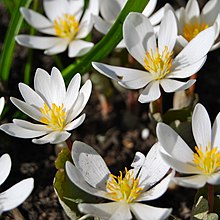Bloodroot
| Bloodroot Sanguinaria canadensis |
|
|---|---|
 |
|
| Scientific classification | |
| Kingdom: | Plantae |
| (unranked): | Angiosperms |
| (unranked): | Eudicots |
| Order: | Ranunculales |
| Family: | Papaveraceae |
| Genus: |
Sanguinaria L. |
| Species: | S. canadensis |
| Binomial name | |
|
Sanguinaria canadensis L. |
|
Sanguinaria canadensis (bloodroot) is a perennial, herbaceous flowering plant native to eastern North America. It is the only species in the genus Sanguinaria, included in the family Papaveraceae, and most closely related to Eomecon of eastern Asia.
Sanguinaria canadensis is also known as bloodwort,redroot,red puccoon, and sometimes pauson. It has also been known as tetterwort, although that name is also used to refer to Chelidonium majus. Plants are variable in leaf and flower shape and have in the past been separated out as different subspecies due to these variable shapes. Currently most taxonomic treatments include these different forms in one highly variable species. In bloodroot, the juice is red and poisonous.
Bloodroot grows from 20 to 50 cm (7.9 to 19.7 in) tall. It has one large basal leaf, up to 12 cm (4.7 in) across, with five to nine lobes. The leaves and flowers sprout from a reddish rhizome with bright orange sap that grows at or slightly below the soil surface. The rhizomes grow longer each year, and branch to form colonies. Plants start to bloom before the foliage unfolds in early spring. After blooming the leaves expand to their full size and go summer dormant in mid to late summer.
The flowers bloom from March to May depending on the region and weather. They have 8-12 delicate white petals and yellow stamens, and two sepals below the petals, which fall off after the flowers open. The flower stems are clasped by the leaves. The flowers are pollinated by small bees and flies. Seeds develop in green pods 40 to 60 mm (1.6 to 2.4 in) long, and ripen before the foliage goes dormant. The seeds are round and black to orange-red when ripe, and have white elaiosomes, which are eaten by ants.
...
Wikipedia

